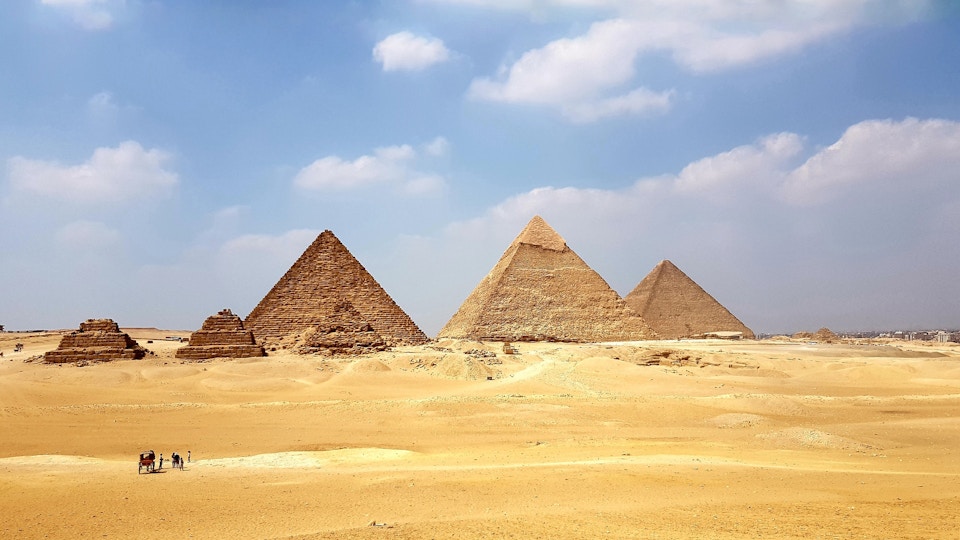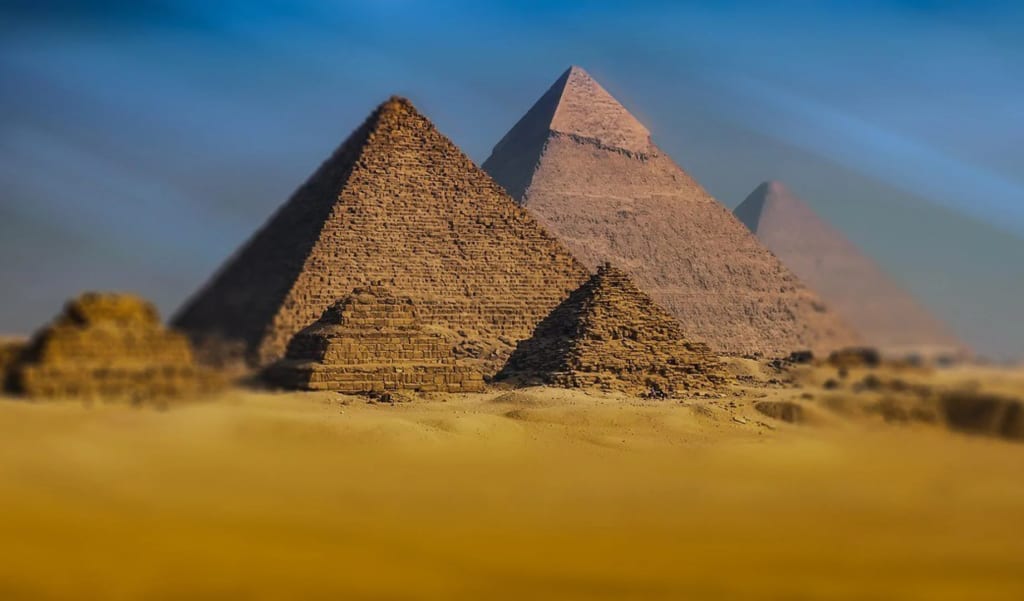
Overview of the Pyramids of Giza
Introduction to the Pyramids of Giza
The Pyramids of Giza stand as monumental reminders of ancient Egyptian civilization, capturing the imagination of historians and travelers alike. These remarkable structures were constructed during the fourth dynasty of the Old Kingdom, primarily as grand tombs for the pharaohs.
Historical Significance
Their historical significance is profound, acting as:
- Royal burial sites showcasing ancient Egyptian beliefs about the afterlife.
- Symbols of pharaonic power and engineering prowess.
- Key influences on architecture and culture throughout history.
Location and Layout
Situated on the Giza Plateau, just outside Cairo, these pyramids form an impressive triangle that also includes the Great Sphinx. Visitors eagerly navigate the layout to explore:
- The Great Pyramid of Khufu, the largest.
- The slightly smaller Pyramid of Khafre.
- The Pyramid of Menkaure, the smallest of the trio.Together, they invite exploration and admiration, embodying the legacy of the ancients.
Construction Techniques and Materials
Building Process
The construction of the pyramids was a remarkable feat that took decades to complete. Skilled laborers, not slaves as often believed, worked in cohesive teams. They followed a series of steps:
- Planning and design, involving precise calculations.
- Quarrying and transporting massive limestone blocks, which often weighed several tons.
- Assembling the blocks with remarkable accuracy to create a stable structure.
Tools and Materials Used
The tools and materials used in the construction were surprisingly innovative for their time:
- Copper chisels and stone hammers for shaping stones.
- Ramps made of mudbrick and limestone to move the heavy blocks into place.
Architectural Innovations
The ingenuity of ancient Egyptian architects cannot be overstated, as they integrated architectural innovations such as:
- The corbel arch, which allowed for vaulted spaces within the pyramids.
- The use of precise alignment with celestial bodies for religious significance.These techniques not only demonstrate remarkable engineering skills but also a deep understanding of construction that continues to inspire architects today.
The Great Pyramid of Khufu
Background of the Great Pyramid
The Great Pyramid of Khufu, also known as the Pyramid of Cheops, is the largest of the Giza pyramids and a testament to ancient engineering. Completed around 2560 BC, it served as the tomb for Pharaoh Khufu, showcasing the immense power and ambition of the Fourth Dynasty.
Interior Structure
Inside, the pyramid features a complex layout, including:
- The Grand Gallery, a remarkable ascending passage.
- The King’s Chamber, built entirely of red granite.
- The Queen’s Chamber, thought to be symbolic rather than functional.
Theories and Mysteries Surrounding Khufu’s Pyramid
Various theories surround the pyramid’s construction and purpose, leading to endless fascination:
- Some propose it was built as a monumental tomb, while others believe it served astronomical purposes.
- The precision of its alignment with cardinal points sparks ongoing debates among historians and archaeologists.
These mysteries add to the allure of the Great Pyramid, ensuring its place as one of humanity’s most remarkable achievements.
The Pyramids of Khafre and Menkaure
Description of Khafre and Menkaure Pyramids
Situated adjacent to the Great Pyramid, the Pyramids of Khafre and Menkaure complement the grandeur of Giza. The Pyramid of Khafre stands at a height of 136 meters, and its unique limestone casing at the top gives it an imposing appearance. Meanwhile, the Pyramid of Menkaure, smaller at 65 meters, exhibits exquisite red granite at its base, demonstrating the evolution of pyramid construction techniques.
Purpose and Function
Both pyramids served the primary function as royal tombs. These tombs were designed to ensure:
- The safe passage of pharaohs into the afterlife.
- A place for the pharaoh to become one with the gods, emphasizing their divine status.
Architectural Features
Architecturally, both pyramids boast remarkable features:
- Khafre’s Pyramid has a mortuary temple that connects to a causeway leading to the Valley Temple, emphasizing ritual practices.
- Menkaure’s Pyramid includes three smaller queens’ pyramids, highlighting the importance of the royal family.
Together, Khafre and Menkaure’s pyramids enrich Giza’s historical tapestry, showcasing not just the grandeur of their builders but also the spiritual beliefs that shaped ancient Egypt.
Preservation and Conservation Efforts
Challenges in Preserving the Pyramids
As magnificent as the Pyramids of Giza are, they face numerous preservation challenges. Factors such as:
- Pollution from nearby urbanization.
- Erosion caused by natural weather elements.
- Vandalism and tourism-related wear and tear.These issues threaten the structural integrity and aesthetic beauty of these historical wonders.
Conservation Initiatives
In response, various conservation initiatives have been put in place:
- Collaborative efforts between Egyptologists and global conservation organizations.
- Use of advanced technologies like lasers to monitor structural changes.
- Education programs aimed at visitors to promote responsible tourism.
Future of the Pyramids
Looking forward, the future of the Pyramids of Giza hinges on continued commitment to their preservation. Strategies such as:
- Increasing funding for maintenance.
- Implementing stricter regulations on tourism.
- Fostering community involvement in conservation efforts.These initiatives promise to safeguard these ancient treasures for generations to come, ensuring that the story of ancient Egypt continues to inspire and educate the world.
Legacy and Cultural Significance
Influence on Architecture
The Pyramids of Giza have profoundly influenced architectural designs across centuries. Their innovative structures have inspired:
- Neoclassical buildings such as the Louvre Pyramid in Paris.
- Modern skyscrapers incorporating angled glass reminiscent of pyramid silhouettes.These ancient wonders showcase how foundational design principles can transcend time.
Cultural Impact
The cultural significance of these pyramids is equally profound. They symbolize:
- Human ingenuity and the quest for immortality.
- The rich tapestry of ancient Egyptian mythology and religious beliefs.The pyramids continue to captivate artists, writers, and filmmakers, embedding themselves into global culture.
Tourist Attractions and Visitation
As a result of their allure, the Pyramids of Giza draw millions of tourists each year. Visitors can experience:
- Guided tours that delve into their history.
- The opportunity to ascend the causeways and marvel at their grandeur.This influx of tourism not only bolsters Egypt’s economy but also fosters a global appreciation for ancient heritage, ensuring that the legacy of these incredible structures endures.
Conclusion
Recap of Architectural Marvel of the Pyramids
The Pyramids of Giza stand as testaments to ancient Egyptian architectural genius. With their precise engineering, grand scale, and innovative techniques, they continue to fascinate both scholars and laypeople alike. Each pyramid tells a story of ambition, spirituality, and the desire for immortality, encapsulated in stone.
Enduring Legacy of the Giza Pyramids
As we reflect on their impact, it’s clear that the legacy of the Giza pyramids transcends time and culture. They inspire:
- Modern architecture.
- Scholarly pursuits in understanding ancient history.
- A deeper appreciation for human creativity and perseverance.
These timeless structures not only represent a significant chapter in human history but also remind us of the mysteries yet to be uncovered, ensuring they will remain an essential part of our collective heritage for generations to come.
